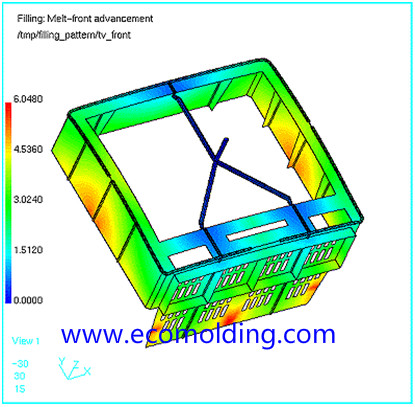The fluidity of plastics:An indicator to compare the injection molding difficulty level of a plastic material, which like viscosity, is dependent on molding conditions and the properties of polymers.

Indicators for measuring the fluidity of plastics:
The relative molecular mass, melt flow index, length of the Archimedean spiral, apparent viscosity and the flow ratio (flow length / product wall thickness) of polymers. If the relative molecular mass is small, the melt flow index is high, the spiral is long, the apparent viscosity is low and the flow ratio is high, then the fluidity is good.
The fluidity of common thermoplastics can be classified into 3 categories:
| Fluidity | Plastic Names | Formula for Calculating Wall Thickness |
| Good | PE / PA / PP / PS / CA / SPVC / PBT / PET | t=(0.01L+0.5)×0.6 |
| Medium | AS / ABS / POM / PMMA / CP | t=(0.01L+0.8)×0.7 |
| Poor | PC / HPVC / PPO / PSF / Fluoroplastics | t=(0.01L+1.2)×0.9 |
| 1: High material temperature leads to increased fluidity (PP, PA, PMMA and PC are more sensitive) |
| 2: High pressure leads to increased fluidity (PE and POM are more sensitive) |
| 3: Gating system, cooling system, section size, venting system and profile finish all have certain influence on plastic fluidity |
The fluidity of plastics varies with molding process conditions. Good fluidity is associated with high molding temperature and high injection pressure. In addition, mold structure also influences the level of fluidity.
The fluidity of plastics has a great influence on the quality of plastic parts, mold design and the molding process. It is not easy for plastics with poor fluidity to fill the cavity, leading to defects such as insufficient filling or weld lines. Therefore, a high molding pressure is required to well complete the injection molding process. On the contrary, plastics with great fluidity are able to fully fill the cavity under relatively low molding pressure conditions. However, great fluidity tends to cause severe flashing during the plastic injection molding process. Therefore, when selecting plastics for the injection molding of a plastic part, the ones with appropriate fluidity should be used on basis of the structure, size and molding method of the plastic parts, so as to obtain satisfactory results. In addition, during mold design, the parting surface, gating system and the feeding direction should all be considered according to the fluidity of the chosen plastic; the selection of molding temperature should also take the fluidity of plastics into consideration.
